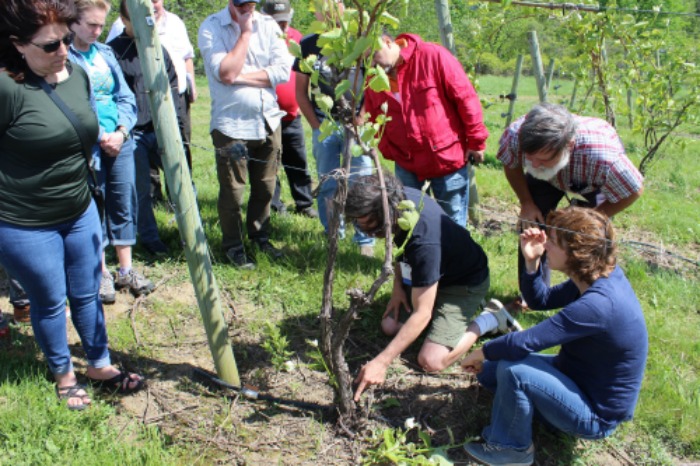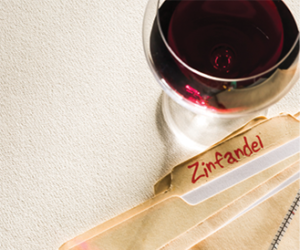 So you truly enjoy making your own wine. You’ve been making wine for years, or maybe have just made a couple of wine kits. What’s next? Where might you learn more or gain even a higher appreciation of your hobby? Consider a winemaking club. Making wine is fun whether you like to make it alone or with friends. Getting involved with a dedicated group of home winemakers, however, can have some real advantages. For starters, it’s a good excuse to have a set time each month for getting together with like-minded people and talk about wine. Meetings are also a great opportunity to taste and evaluate wines — your own, those of fellow club members, as well as commercial wines. Clubs can also be a great way to share in the cost of ingredients if you want to order in bulk, or for large pieces of equipment that can be shared. They are also an opportunity to try out some roles and responsibilities that you might not have in your everyday life; perhaps you’ve never organized an event, or you’ve never served on a board of directors — a home winemaking club gives you the chance to try on a different hat . . . all under the guise of making your own wine.
So you truly enjoy making your own wine. You’ve been making wine for years, or maybe have just made a couple of wine kits. What’s next? Where might you learn more or gain even a higher appreciation of your hobby? Consider a winemaking club. Making wine is fun whether you like to make it alone or with friends. Getting involved with a dedicated group of home winemakers, however, can have some real advantages. For starters, it’s a good excuse to have a set time each month for getting together with like-minded people and talk about wine. Meetings are also a great opportunity to taste and evaluate wines — your own, those of fellow club members, as well as commercial wines. Clubs can also be a great way to share in the cost of ingredients if you want to order in bulk, or for large pieces of equipment that can be shared. They are also an opportunity to try out some roles and responsibilities that you might not have in your everyday life; perhaps you’ve never organized an event, or you’ve never served on a board of directors — a home winemaking club gives you the chance to try on a different hat . . . all under the guise of making your own wine.
Getting Started
So how do you get a wine club started if there aren’t any active groups near where you live? Your first stop should be your local winemaking supplier.
For a number of years I searched for a local winemaking club to join where I live in the Hudson Valley of New York, but there were unfortunately little to no options. A few years ago, however, the local homebrewing and home winemaking supply store, Pantano’s, started up a homebrewing club at the suggestion of some of his patrons. And recently I noticed a sign-up sheet for anyone interested in a home winemaking club. I was excited, to say the least! I have known Pantano’s owner, Jerry, for a number of years, so I asked him about it; like the homebrew club, a number of patrons on the winemaking side had expressed interest in a winemaking club. After talking to Jerry for a while, he asked if I would help out in getting the club off the ground. Jerry knows that I, like Liam Neeson in “Taken,” have a set of certain skills; in my case strong organizational skills. Based on what I envisioned for a winemaking club, I built a basic schedule for the year and utilized Jerry’s sign up sheets to build an email group. I got this, along with a basic “welcome” note, out to the more than thirty sign-ups via email. Jerry was nice enough to provide the venue for the club meeting at the store, which has a very large room on the side that works perfectly for large gatherings.
Our club had our first, very informal, meeting at the end of January 2015. In total, there were ten people in attendance — not bad. The group varied from home winemakers who had been making wines successfully for a number of years, to those who planned to start their first kit.
Our group met again near the end of February. This time, while still informal, we had a basic presentation on winemaking – Winemaking 101. There was also a big spread of food and a table filled with homemade and commercial wines to taste. Also, the group expanded from ten interested parties to more than twenty! But although the informal meetings are working great for now, I needed to know how our group could become a “real” home winemaking club? How do we take it to the next level and beyond? To answer these questions, I reached out to some much more seasoned home winemaking clubs around North America to get some ideas of what our club can do.
One of my first connections was to Gin Yang, the current membership co-chair for the Sacramento Home Winemakers (SHW) in Sacramento, California, which was established in 1973. She offered me the following:
“SHW was established as a non-profit club with the mission of education and promoting home winemaking. Originally, meetings were held in members’ homes, and as the club grew, SHW held monthly meetings at a German meeting hall in Sacramento. SHW is a volunteer organization with by-laws that are published on the Club’s website: www.sachomewine.com. Leadership is provided by an annually-elected executive board: President, vice president, treasurer, secretary, and membership chair. The Board of Directors is comprised of four past presidents and the current president.
“SHW is the oldest continuous operating home wine club west of the Rockies. In 2005, membership was around 80–90 household memberships (1–2 people residing at same address). We ended last year (2014) with 170 members. We’ve had a surge of memberships in the past five years, and the numbers are holding steady with a slight annual increase. We think that a combination of strong technical programs and increased interest in winemaking has increased the club’s membership. After all, we live in amidst of some of the best wine grapes in the world!
“The club meets monthly on the third Wednesdays in the evenings. We focus on education and provide varied technical programs. Our speakers come from commercial wineries, the industry, and UC-Davis, and talk about varietals, problems and fixes, trends, etc. Almost all of the speakers at the WineMaker Magazine Conferences have been guest speakers/evaluators at SHW. Three or four of the monthly meetings throughout the year are evaluations. This is when members bring in last harvest’s wines for evaluations by professional winemakers, who suggest fixes to make the wine better if necessary. Members bring two 750-mL bottles and we all taste along with the evaluators and learn together.
“We supplement the monthly meetings with other activities including Winemaking 101 and Winemaking 201. We also have a beginning winemakers focus group (group crush for newbie winemakers) with assigned mentors. The mentors follow the new winemakers through the process until they bottle, and then those winemakers turn around and help with the incoming group. Other activities include home winery tours, wine tastings, UC-Davis viticulture and enology special events, field trips, and social dinners. We have mentors who mentor on all aspects of winemaking including making dry wines, dessert wines, fruit wines, sparklers, and Ports. Mentors also provide guidance on starting and maintaining home vineyards. We also orchestrate group buys, which allows home winemakers access to growers who sell fruit in larger quantities.
“The Club rents winemaking equipment for a nominal fee, including a destemmer-crusher, basket presses, filter, and corker. Starting in February of this year, we also run harvest and chemical panels for a small fee, including Brix, free SO2, malolactic fermentation (MLF), and total acidity (TA).
“We encourage members to enter wine and label competitions and also help with the home winemaking competition and home winemaking booth with the California State Fair. We award a Winemaker of the Year award to one of our members based on their performance in competitions for the year. We recognize members for their volunteerism with annual awards: Service Beyond the Crush. We also applaud members with annual awards: Educator of the Year, Rookie Winemaker, Most Improved Winemaker, and present a non-member Community Partner (might be a vineyard owner or commercial winemaker).
“I think SHW’s strength is staying focused on its mission of education. Half of the learning is in the camaraderie, whether it’s sharing a bottle with fellow winemakers at the meeting, participating in group crushes, or generously sharing resources. Managing SHW involves many dedicated volunteers who bring a wealth of resources and energy.”
As I finished reading the information from Gin I immediately thought, “Where do I sign up?” The 2,900-mile trip was just a bit too far for me, however. So then I looked over what Gin’s club had to offer and how long it took them to evolve to what they are today. I felt that my local club had their work cut out for them if they wanted to achieve some of the same standards, but what an amazing group of goals that Gin had provided for us.
My next wine club contact was Gary Reynolds, President of the Amador Winemakers Association (www.amadorwinemakers.org), another California-based home winemaking club (Amador County). Gary offered the following information about starting up a home winemaking club:
“You first need to decide what you want the club to do. Talk about wine, make wine, have wine judging events — there are a whole host of things that can be done. I would get a few people together who are making wine and find out what they’re interested in achieving.
“We currently have 98 members. We also have a lot of equipment that the members can use. We have an annual crush, where we buy a few tons of grapes and divide them up among the different members based on the price we pay and how much each member wants. We have an annual BBQ, Christmas party, a spring trip to go wine tasting at commercial wineries and visit a vendor, such as a barrel making company. We have a constitution, president, VP, secretary, treasurer, and equipment manager, and we elect this team every two years. We have a meeting once a month and we put on an annual wine competition where we bring in professional judges.”
Gary’s points give our club some more things to consider. The input from these two very helpful individuals provided enough ideas to keep most any club, new or not so new, striving to be better and offer more about the wonderful world of home winemaking.
Basic Principles
But what about on the most basic levels if you are just forming a club? How do you get a group started and keep it going? First of all, make it easy for people to get basic information and find out what’s going on with your winemaking club. If they have to search for you, they won’t come to meetings. It’s inexpensive to create a basic website these days and a website is an easy way to get your message out there to both members and anyone interested in joining the club.
You can also establish pages for your club on social media like Facebook, Twitter, Google+, etc. and keep them active — be sure to login at least a few times a week to see if anyone has tried to contact you for more information about joining. As my club has already done, establish an email contact list and keep it active and fresh. Be sure to get contact information from any new members as they join. You can also make a monthly email newsletter.
Taking some advice from Gin and Gary, make sure you have a clear message in mind when you establish a winemaking club. Are you getting together just to make wine? Will there be a learning component? Narrow down your mission and make it known to everyone who is interested in joining. Make it specific, but keep it approachable. This will ensure that everyone in the club understands what the goals are from the very beginning.
When choosing a meeting space, try to find a home base that is relatively convenient for all current and potential members. A natural choice (as our club is lucky to have) is a local winemaking supply store. Other good spots are local restaurants (with good wine lists and space for a group, of course), or local community centers with meeting space. Be sure to always approach your potential host for permission, discussing your intentions and needs for the space —many places might not allow guests to bring homemade wines onto their premises for insurance purposes. They might also have other groups committed to the space and time. You could also rotate meetings amongst club members’ homes once you have a core group of committed attendees. Just be sure that if you have a rotating schedule that you post the schedule ahead of time and make sure everyone knows when and where you will be meeting. It only takes showing up at the wrong place once or twice to turn off a new member.
Maintaining the Club
In the beginning, a home winemaking club may just be as simple as getting together with a few friends each month and talking about winemaking informally. As your group grows, however, it’s important to develop and structure planned events and meeting themes to keep people interested. Make sure everyone feels welcome and a part of the club and you will see your group maintain the camaraderie for many years to come.
Also, be very up front about the costs and use of dues, if you choose to collect them. For many people, the money spent on home winemaking is carved out of tight budgets and the choices you make for spending dues can alienate a member if they feel like they don’t have a say in how their money is spent.
Expanding the Club
Home winemakers may cycle in and out of the hobby, or they may move away, take different jobs with conflicting hours, or encounter family commitments — all of which can cause your winemaking club ranks to dwindle if you’re not actively recruiting and welcoming new members. Winemaking clubs can also get stale without ideas and input from new members. Stay committed to welcoming anyone new and to getting your club’s name out there, even after you’ve established a core group of home winemakers — you never know who will be the next club president.
Home winemakers can find new club members through teaching and making themselves available to winemakers with less experience. If you know enough to make wine then you can teach someone else, volunteer your services to your local shop owner, or organize a class at your local community college or community center. If you don’t want to teach, try just reaching out to the newer winemaker in your group and offering an extra set of hands for their next vintage — mentoring can be an excellent experience for both parties.
In addition to these ideas, do what I did and contact other winemaking clubs for advice. I got some excellent feedback from Gin and Gary, and I’m sure there are many more that would be willing to help you. Reach out, do some due diligence, get a home winemaking club going, and don’t look back.
Related Link:
Looking for a club in your area? Start with WineMaker’s online directory: https://winemakermag.com/resource/club-directory
One activity that wine clubs do well is organizing home winemaking competitions. Above, the Sacramento Home Winemakers show off some of their winemaking ribbons at their annual June Jubilee. If your club is still in the early stages, get members involved with volunteering at regional wine competitions. You can later use the experiences to organize your own event.
A great way to give your home winemaking club meeting some structure, while also focusing on education, is to invite expert guest speakers to speak to the group. Try reaching out to local and regional commercial winemakers, companies who make winemaking supplies (barrel makers, yeast companies), as well as even some of the award-winning home winemakers within the club’s ranks.







